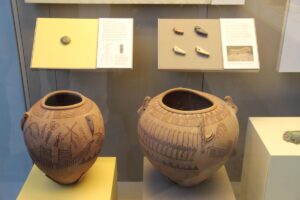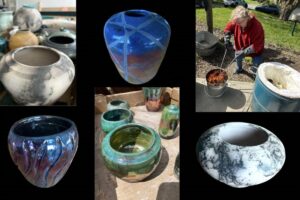
Ancient Greek pottery is one of, if not the most important, remnants of the history of Greece. They are a window to the daily lives of ordinary citizens and nobles alike. These ceramics also stood the trial of time, bearing the symbols of ancient Greece’s culture, superstitions, and artistic vision.
Greek pottery evolved over centuries. The techniques used to create them were intricate, resulting in very well-preserved antiques signaling the shifts in cultural and artistic trends.
With this article, I’ll try to paint a clear picture of ancient Greek pottery, from its functional uses to the techniques and styles that defined it through different periods.
Table of Contents
The Function and Role of Greek Pottery
Pottery was a significant part of Greek life. Its importance spanned from practical usage to ceremonial purposes.
The Greeks were master craftsmen creating vessels like Lekythoi, Hydrai, and Kylixes, with such accuracy and intricacy. Here are the ways these vessels might have been used:
Storage and Transportation:
Pottery was invented as a medium to store non-perishable goods. The clay utensils helped keep the temperature cool and dry, leading to longer shelf life. This made storage much easier and safer.
The Greeks noticed the lightweight but sturdy property of ceramics and started using them as the primary means for transportation. This worked better than other methods as clay pots are lightweight and durable. They were also foolproof against the elements.
Eventually, the idea spread throughout the empire, and different styles of ceramic pots started to appear according to specific needs, such as long-necked vessels for liquids, and wide pots with handles for bulk storage of grains.
Here are a few examples of Greek potteries used for storage and transportation:
Amphorae
These were large storage jars used mainly for transporting oil, wine, and grains across the Mediterranean.
Amphorae have slender necks and a pointed bottom. This design allowed them to store tightly against each other, leading to safer transport.
The vast majority of them were used to store and transport wine across the empire and the Mediterranean Sea.
Pithoi
Pithoi (singular: Pithos) were even larger jars. Their primary function was to store things in bulk.
These jars were almost the size of an adult person. The external shapes of them are simple with little variations. These have a base for standing, sides nearly straight or generously curved, and a large mouth with a lid, sealed for shipping.
Pithoi were used mostly for shipping and storing, but once discarded, they were used for other purposes as well. Most commonly as bathtubs, and even as coffins.
Dining and Drinking:
Dining utensils are the oldest technology ever found on Earth, other than hunting tools. So naturally, a diverse mode like pottery would evolve from such items.
Here are a few ceramic crafts made for dining and drinking purposes:
Kraters
They were designed to mix wine and water during symposia (banquets).
Kraters are big, wide-mouth jars. They were, in fact, so large that once filled with liquid, they couldn’t be moved. These jars served as a centrepiece of a banquet, and wine and water were mixed in them. Then guests would scoop out the drinks with kylixes or amphorae to drink from.
Kylixes
Kylix is a type of drinking cup defined by its broad and shallow bowl, small bottom, and two horizontal handles. These cups were designed in a manner so that they could be drunk out of while reclining.
These cups were mostly used in banquets or symposia, where reclining while sitting is customary. Their designs made them ideal for those situations.
kantharoi
Kantharoi were deep cups, common drinking vessels. These cups had a tall pedestal, and two large handles, and looked like modern wine glasses with handles.
Kantharoi were used for holding wine during dining and rituals. They had excellent motifs painted on them and were thought to be an attribute of Dionysus (the God of wine).
Ceremonial Use:
Lekythoi
tall and narrow-necked vessels, often with a single handle, held perfumed oils and were often placed in tombs as grave offerings.
Rhyta
often shaped like animal heads (especially bulls), were used in religious rituals for pouring libations.
Kraters
They were also used for funeral proceedings besides symposia.
Household Use:
Household pottery is such a broad term, as pretty much all the other categories can fit in here, depending on the diverse use cases of these jars. However, there is some commonality between the household pottery that separates it from other kinds.
Here’s an example of this:
Hydria
They were used to carry water, and cooking pots served everyday culinary needs.
But with time, they evolved into much more, such as the vessel for collecting ballots and storing the ashes of the deceased. However, depending on the need, these pots were decorated accordingly.
Ranging from solid colors to intricate mythical figures, these vases were diverse in decoration.
They changed in design and shape quite a few times. The most popular one resembles a modern-day large vase with two horizontal handles.
Major Styles and Periods of Greek Pottery
Greek pottery went through several transformations defined by stylistic trends and necessities. These changes reflect changes in artistic expression and societal influences.
Here are the major eras and their defining styles:
Geometric Period (c. 900–700 BCE)
The Geometric period marks the earliest phase of Greek pottery. Characterized by:
- Strict, symmetrical designs using geometric shapes like meanders, triangles, and concentric circles.
- Limited representation of human figures, which were highly stylized.
- Large funerary vases, such as Dipylon amphorae, were used as grave markers, often depicting mourning scenes and funeral processions.
This being the earliest of the artistic trends, it never really went away. They diversified and combined with other styles, evolving into much, much more.
However, they don’t diversify much in terms of shapes. Larger vases were used as storage or grave markers, whereas smaller ones served as urns for the dead.
Its designs were also thematically similar to death and mourning. With Egyptian gods and mortals surrounding the deceased being the most common pattern. However, these motifs were highly stylized and kept with the geometric theme.
Orientalizing Period (c. 700–600 BCE)
During this phase, Greek art absorbed influences from the Near East and Egypt, which reflected in their pottery and architecture. This led to two of the richest cultures being amalgamated into a single form of art.
With this culture exchange, the Greek pottery evolved into more detailed pieces of ceramics and saw an influx of ceremonial themes being interpreted into the pieces.
Here are a few features this exchange brought to ancient Greek pottery:
- Curvilinear and floral motifs replace the rigid geometric patterns.
- Depictions of animals, mythological creatures, and narrative scenes.
- The use of black-figure techniques began to emerge in Corinthian pottery.
Black-Figure Technique (c. 620–480 BCE)
This era truly brought about a revolution with techniques that allowed for detailed and expressive imagery.
The black-figure technique in ancient Greek pottery involved painting figures and details in glossy black slips against a red-orange clay background, with details added through incising. This technique offered a more flexible way to depict the subjects.
This technique featured attributes like:
- Figures painted in a black slip on the natural red clay background.
- Fine details are incised into the figures, exposing the red clay beneath.
- Mythological themes, such as the exploits of Hercules and Achilles, were popular subjects.
- Notable artists: Exekias and the Amasis Painter, known for their dynamic compositions and intricate details.
The striking black drops were created using completely closed-off kilns and green wood smoke. This way, the inner layers remain orange. Then the subjects were carved on the walls, allowing intricate details to be added.
Red-Figure Technique (c. 520–300 BCE)
Developed in Athens, this technique reversed the black-figure method. It’s basically a stylistic distinction where different characters are painted over a black background. The figures were left red or neutral oranges, giving off a striking contrasted look.
- Figures remained red, with the background painted black.
- A three-stage firing process was required to build them.
- Allowed for greater flexibility in depicting human anatomy, movement, and emotions.
- Notable artists: Euphronios, the Berlin Painter, and the Andokides Painter.
This style dominated Greek pottery for centuries, offering more realism and artistic expression. They closely resemble Egyptian pottery. However, the subjects were different, such as daily life, mythology, and religious rituals.
White-Ground Technique (c. 500–400 BCE)
This method was primarily used for funerary vases.
The white-ground technique refers to the application of a white clay slip on the surface of a vessel before adding figure decoration. This technique is most common in Athenian black-figure vases.
- A white slip was applied to the vase, allowing for more detailed painting.
- Colors like red, blue, and gold were added to the decoration
- Common themes included domestic life, funerary rites, and mythological figures.
These were mostly used for ceremonial pots, meaning jars like Pithoi or such. These decorations were master-crafted, and even after thousands of years, they’re quite intact.
The Artistic and Cultural Significance of Greek Pottery
Greek pottery was invented out of necessity, but it evolved into much more than that. It became a visual representation of their cultural and artistic taste. Millennia later, these potteries opened a window to various aspects of social, political, and even religious life.

Let’s take a deeper look:
Storytelling and Mythology:
Greek mythology is as rich as it gets. These mythologies can be a great subject for any form of art. Pottery from that time clearly shows narratives inspired by them.
A few good examples include the Trojan War, with figures like Achilles, Hector, and Ajax appearing frequently. Gods and heroes such as Zeus, Athena, and Dionysus were also popular subjects.
Additionally, everyday life was a major theme, with pottery illustrating athletic competitions, banquets, and moments of warfare.
Political and Social Commentary:
Political events of ancient Greece are highlights of history. Sure enough, these were popular subjects of pottery as well.
Events like the Olympic Games and other sporting events, scenes of warfare, and occasionally references to historical conflicts such as the Persian Wars were depicted immaculately in various forms of pottery, amazing historians to this day.
Women in Greek society were also represented, often shown in domestic settings, at weddings, or participating in religious rituals. However, this genre was less popular compared to other subjects.
The Legacy of Ancient Greek Pottery
Greek pottery had a lasting influence that spanned millennia. The most notable example is the Romans adopting many Greek techniques, particularly the red-figure style, incorporating them into their artistic traditions.
Archaeologists continue to rely on Greek pottery to help date excavation sites and understand ancient trade networks.
Today, museums around the world, including the British Museum, the Louvre, and the Metropolitan Museum of Art, showcase Greek vases as part of their collections, allowing modern audiences to appreciate their artistic and historical value.
This influence is still observed today, as various forms of modern art, particularly ceramics and graphic design, draw inspiration from ancient Greek pottery’s aesthetics, forms, and storytelling methods, with artists exploring these influences in new ways.
Conclusion
Ancient Greece stands at the pinnacle of culture, history, and art. The pottery from those eras represents a vast range of artistic trends and socio-economic influences.
These potteries depict many aspects of Greek history, from warfare to everyday domestic affairs. Sports, historical events, political events, mythology, and warfare were the most popular subjects among them.
Throughout the centuries, these ancient Greek potteries evolved in stylistic ways to accommodate the trends of the corresponding eras. These divisions are so clear that historians now use them as a reference to date other artifacts of the time.
Greek pottery remains a window into the artistic and social values of an ancient civilization. Its legacy continues to inspire art, archaeology, and historical scholarship today.
Frequently Asked Questions
What were the main types of Greek pottery?
Greek pottery included amphorae (storage), kraters (wine mixing), kylixes (drinking cups), lekythos (oil containers), and hydria (water jars), among others.
Why is Greek pottery so important to historians?
Greek pottery helps archaeologists date ancient sites, understand trade networks, and gain insights into daily life, mythology, and artistic traditions.
What is the difference between black-figure and red-figure pottery?
Black-figure pottery featured black-painted figures on a red background, with details incised. Red-figure pottery reversed this, allowing for greater detail and realism in human figures.
Who were some famous Greek potters and painters?
Notable figures include Exekias (black-figure), Euphronios (red-figure), and the Berlin Painter, each known for their masterful compositions and storytelling.
How did Greek pottery influence other cultures?
Greek pottery styles influenced Etruscan, Roman, and later European ceramic traditions, shaping artistic techniques for centuries.
Where can I see ancient Greek pottery today?
Major museums like the British Museum, the Louvre, and the Metropolitan Museum of Art have extensive collections of Greek pottery.
How was Greek pottery made?
Greek pottery was crafted from fine clay, shaped on a wheel, and fired in kilns at different temperatures to achieve the red- and black-figure effects.

I’m Farzana, a writer with over 5 years of experience and a genuine passion for business, home improvement, fashion, and digital marketing. I love creating content that’s engaging and easy to relate to—whether I’m breaking down a marketing strategy, sharing simple home tips, or exploring the latest style trends. Writing allows me to connect with people across different interests, and I’m always excited to bring a fresh, practical perspective to every topic I cover.




